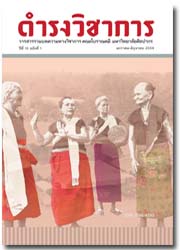A Study of Sculpture of Hevajra in Khmer Art
Keywords:
Hevajra, Vajrayana, Khmer artAbstract
Hevajara is an important minor deity of Vajrayana Buddhism. It is also known as the Guardian Angel or Yidam. His duty is to protect Buddhism. The worship of Hevajara first appeared in the Pala Dynasty, from the 13th to the 18th centuries. Unlike in Nepal and Tibet, where Vajrayana was also practiced, sculptures of Hevajara are not as prevalent in India. In Cambodia, sculptures of Hevajara were first found in the art of Angkor Wat, and they became very popular in Bayon art, during the 17th-18th centuries. The sculptures, made of various materials, such as stone, bronze and ivory, appear in two forms: Kapaladhara and Shastradhara. The worship of Hevajara was very important to the Khmer Empire, especially during the reign of King Jayavarman VII. This explains the greater variety in artistic styles of Hevajara’s sculptures in Angkor Wat than those found in India. It is also ascribed to the iconographic characteristics of Hevajara’s sculptures unique to Khmer Art.
References
ผาสุข อินทราวุธ, 2543. พุทธปฏิมาฝ่ายมหายาน. กรุงเทพฯ: โรงพิมพ์อักษรสมัย. วรรณวิภา สุเนต์ตา, 2546.
คติรัตนตรัยมหายานในศิลปะเขมรช่วงพุทธศตวรรษที่ 18 ที่พบในภาคกลางของประเทศไทย. วิทยานิพนธ์ศิลปศาสตรมหาบัณฑิต ภาควิชาประวัติศาสตร์ศิลปะ คณะโบราณคดี มหาวิทยาลัยศิลปากร.
ผาสุข อินทราวุธ, 2548. ชัยวรมันที่ 7 มหาราชองค์สุดท้ายของอาณาจักรกัมพูชา. กรุงเทพฯ: สํานักพิมพ์มติชน.
หม่อมเจ้าสุภัทรดิศ ดิศกุล, 2535. ประวัติศาสตร์เอเชียอาคเนย์ถึง พ.ศ. 2000. กรุงเทพฯ: บริษัท รุ่งแสงการพิมพ์ จํากัด.
หม่อมราชวงศ์สุริยวุฒิ สุขสวัสดิ์, 2543. กัมพูชาราชลักษมีถึงศรีชยวรมัน. กรุงเทพฯ: สํานักพิมพ์มติชน.
Bunker E.C. & Latchford D.A.J., 2004. Adoration and Glory: The Golden Age of Khmer Art. Chicago, IL: Art Media Resources.
Chutiwongs N., 1984. The Iconography of Avalokitasvara in Mainland South East Asia. Bangkok: s.n.
Clark J. (ed.), 2007. Bayon New Perspective. Bangkok: River Books.
Getty A., 1962. The Gods of Northern Buddhism: Their History, Iconography and Progressive Evolution Through the Northern Buddhist Countries. Rutland, Vt.: Charles E. Tuttle.
Huntington J.C. & Bangdel D., 2003. The Circle of Bliss: Buddhist Meditational Art. Chicago: Serindia Publications; Columbus: Columbus Museum of Art.
Huntington S.L., 1984. The “Pala-Sena” Schools of Sculpture. Leiden: E.J. Brill.
Jessup H.I. & Zephir T. (eds.), 1997. Sculpture of Angkor and Ancient Cambodia Millennium of Glory. Washington: National Gallery of Art.
Saraswati S.K., 2003. Tantrayana Art: An Album. Kolkata: Asiatic Society.
Sharrock P.D., 2006. The Buddhist Pantheon of the Bàyon of Angkor: An Historical and Art Historical Reconstruction of the Bàyon Temple and Its Religious and Political Roots. Doctoral dissertation. University of London.
Sharrock P.D., 2009. “Hevajra at Bantéay Chmàr.” The Journal of the Walters Art Museum 64/65 (2006/2007) (published 2009).
Sharrock P.D., 2013. “The Tantric Roots of the Buddhist Pantheon of Jayavarman VII.” In M.J. Klokke & V. Degroot (eds.), Materializing Southeast Asia’s Past. University of Hawai’i Press, Hawai’i.
Bust of Hevajra, 2014. Retrieved December 20, 2014, from http://www.metmuseum.org/collection/the-collection-online/search/38304
Dancing Hevajra, 2014. Retrieved December 12, 2014, from http://www.artic.edu/aic/collections/artwork/148419
Hevajra Mandala, 2014. Retrieved December 10, 2014, from http://www.artgallery.nsw.gov.au/collection/works/1.2001/
Seated Buddha Protected by Naga (front), Dancing Multi-Headed Hevajra (back), 2015. Retrieved May 16, 2015, from http://www.metmuseum.org/art/collection/search/64926
Downloads
Published
Issue
Section
License
บทความนี้เป็นผลงานของข้าพเจ้าแต่เพียงผู้เดียว และ/หรือเป็นผลงานของข้าพเจ้าและผู้ร่วมงาน ตามชื่อที่ระบุในบทความจริง และเป็นผลงานที่มิได้ถูกนำเสนอหรือตีพิมพ์ที่ใดมาก่อน





